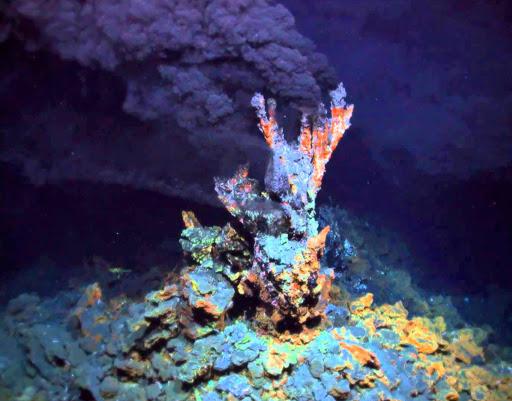Life Originated at Hydrothermal Vents, New Findings Bolster

Image Courtesy: Scinews.com
Over the time, many theories and findings about the origin of life on Earth have emerged, and they have juxtaposed many paradoxes. This quest for discovering the origin of life, however, has never stopped, and scientists continue to come up with new theories.
Modern genetics tells us that the building blocks of the cells are made up of a variety of proteins, which are produced by the message encoded in the DNA. This process is called gene expression. But those cellular building blocks are also needed to produce DNA. Scientists have always wondered how life survived before complex molecules like proteins and DNA emerged in the course of evolution.
One of the latest theories about this has been that life originated in the hydrothermal vents, the fissures in the sea floor that release hot water and some chemicals. A recent study that appeared in the Nature Ecology & Evolution on March 2 bolsters this theory. The study says that its possible for organic molecules to be produced as a result of the reaction between hydrogen and carbon dioxide, the presence of some specific minerals being the essential condition. The organic molecules that can be produced through these reactions are energy-rich and essential for cell growth. The essential minerals are iron rich, and can be found in and around hydrothermal vents.
Thomas Carell, an origin of life chemist at Ludwig Maximilian University of Munich, who was not associated with the study said that the new work is ‘thrilling’. The organic molecules the study generated include formate, acetate, and pyruvate, which Carell calls “the most fundamental molecules of energy metabolism”, the process of converting nutrients into cell growth. The new results support a long-held idea about the origin of life known as “metabolism first hypothesis”. It posits that geochemical processes on early Earth created a stew of simple energy-rich compounds that drove the synthesis of complex molecules, which eventually provided the materials for Darwinian evolution and life.
Modern organisms, including humans, still combine hydrogen and carbon dioxide to produce organic molecules. The pathway of this conversion of inorganic molecules to organic molecules is known as acetyl-CoA pathway and an essential part of bio-energetics. The organic molecules produced through this process drive many biochemical processes that produce essential molecules like proteins, carbohydrates, lipids, etc. In the acetyl-CoA pathway, 11 enzymes take part in a very systematic manner to carry forward the reaction between hydrogen and carbon dioxide to produce organic molecules. Interestingly, in the absence of the coordinated functioning of the enzymes (proteins), hydrogen and carbon dioxide would never react.
However, another question remains. In modern advanced organisms, the proteins can catalyze the reaction of hydrogen and carbon dioxide, but in the earliest life forms, before the sophisticated proteins and other molecules emerged, how did this reaction take place? Two years back, a team of researcher led by Joseph Moran, chemist at the University of Strasbourg, gave some hints about it. His team found that pure metals such as iron, nickel and cobalt could catalyze the reaction between hydrogen and carbon dioxide to form acetate and pyruvate, the key members of the acetyl-CoA pathway.
Moran’s team joined hands with the team of William Martin, an evolutionary biologist at Heinrich Heine University of Dusseldorf, to find out if the hydrogen from hydrothermal vents reacts with carbon dioxide in the presence of some minerals. The choice of hydrothermal vents came out of the fact that it continually spews hydrogen gas into the ocean water and researchers have already found that the amount of carbon dioxide in the oceans during the ancient times was 1,000 times more than it is today. Hydrothermal vents also spew minerals along with hydrogen gas. The joint effort of these two teams resulted in the recent Nature paper.
They took greigite, magnetite, and awaruite, the iron-rich minerals found near the vents and added these to water and passed hydrogen gas and carbon dioxide through the mixture at 100 degree Celsius and 25 bars of pressure. These laboratory conditions were similar to the conditions around the vents. These three minerals catalyzed the reaction between hydrogen and carbon dioxide to form a mixture of organic molecules that include formate, acetate and pyruvate.
Get the latest reports & analysis with people's perspective on Protests, movements & deep analytical videos, discussions of the current affairs in your Telegram app. Subscribe to NewsClick's Telegram channel & get Real-Time updates on stories, as they get published on our website.














